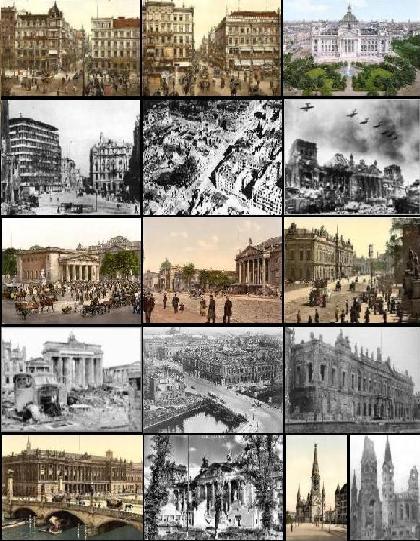
Starting in 1940, Berlin was continually attacked. Between November 18, 1943 and March 1944 alone, Berlin was bombed 24 times by over 1,000 planes of the combined forces of the RAF, RCAF, USAAF and Soviets, dropping up to 2,000 tons of bombs each, and it was continually assaulted until the Russian army took the city in April, 1945. The infrastructure was destroyed.
The so-called “Battle of Berlin” was largely a British bombing campaign from November 1943 to March 1944 launched by Arthur Harris, who boasted: “It will cost us between 400 and 500 aircraft. It will cost Germany the war.” Between November 1943 and March 1944 Bomber Command made 16 massed attacks on Berlin. On December 27, 1943, Arthur Harris had requested that the USAAF attack Berlin as well and relieve the pressure on RAF Bomber Command, however, the Americans continued precision bombing German industry and refused to join the RAF campaign. The 16 raids on Berlin cost Bomber Command more than 500 aircraft and 2,690 of their men lost their lives with nearly 1,000 others becoming prisoners of war. Although devastating to civilians, the British raids failed to meet their primary objective, which was to win the war by bombing Germany until its economy and civilian morale collapsed (in fact, war production in greater Berlin did not fall but continued to rise until the end of 1944).
The first major raid on the night of November 18/19, 1943 caused little damage. The second major raid on November 23/24, 1943 ignited several firestorms and caused extensive civilian damage to the residential areas west of the center, Tiergarten and Charlottenburg, Schöneberg and Spandau. The Kaiser Wilhelm Memorial Church was senselessly destroyed along with the British, French, Italian and Japanese embassies, Charlottenburg Palace and the Berlin Zoo. This raid killed 2,000 and rendered 175,000 people homeless. The following night 1,000 were killed and 100,000 made homeless. A December 17 attack extensively damaged the Berlin railway system. During December and January, constant civilian bombing attacks killed hundreds of people each night and rendered between 20,000 and 80,000 homeless each time. By this time, more than a quarter of Berlin’s total living accommodations were unusable. Another major raid on January 28/29, 1944 hit Berlin’s western and southern residential districts. On February 15/16, 1944 some important war industries were actually hit. These homicidal, vengeance fueled civilian attacks, ineffective though they were, continued until March 1944, causing immense devastation and death.
Out of 245,000 buildings in Berlin, 50,000 were completely destroyed and 23,000 severely damaged; 80,000 (documented) civilians had been killed. There were no trees, no grass, and only blackened corpses of both buildings and people. The city of Berlin, once among the most beautiful and enviable in the world, was in total ruin. It is now generally accepted that the Battle of Berlin was certainly not the success that Harris, who among others wanted nothing less than Germany erased from the map for all time at any cost, had predicted and it cost the lives of hundreds of his own men.
